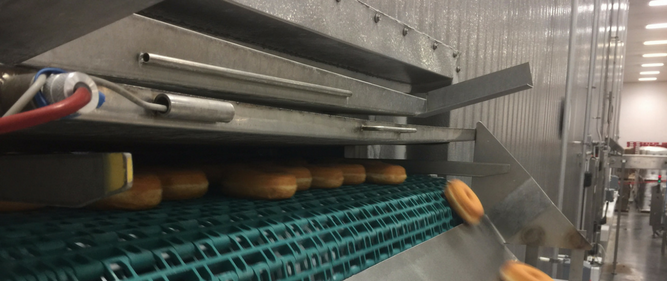Consumer demand for “clean labels” with simple and natural ingredients has been a driving force in the food industry in recent years. In fact, clean-label foods is forecasted to be a $180 billion global market by 2020, and many food manufacturers are reformulating recipes to adapt with the growing trend.
The idea behind clean eating is avoiding foods with preservatives, artificial additives and “ingredients you can’t pronounce.” Although most of these additives are USDA-approved and technically safe to consume, they have undoubtedly developed a stigma among consumers.
Of course, minimizing preservatives in a product reduces its shelf life, so some bakery and snack manufacturers are refrigerating and freezing certain products for the first time.
Striking a balance between simplicity and shelf life
When it comes to removing preservatives, a recipe change typically translates to a processing change. Swapping out artificial additives can add shelf life while shrinking ingredient labels.
For example, I’m currently installing a frozen doughnut line in a plant. These products are often distributed to retailers without refrigeration and with added preservatives, but this particular manufacturer wants to switch things up. We’re configuring an ambient cooling spiral that will get the bulk of the flash heat off the doughnuts, then they will go into a spiral freezer to bring their core temperature down before distribution. This will allow the manufacturer to deliver a quality product with fewer additives.
I’m also working with a pizza delivery chain on their dough production. Their goal is to eliminate preservatives but still create fresh dough that is never frozen. The solution was bringing the dough’s core temperature to around 35 degrees — cool enough to keep the yeast from rising and maintain a week-long shelf life without freezing.
Not only does freezing keep labels cleaner for the end customer, but it also tends to cost less than adding preservatives to the product. However, even snack and bakery companies that do use preservatives are capitalizing on freezing and refrigeration to extend shelf life even more. Some of these manufacturers may not freeze product on the production line, but they package the product with preservatives and store it in subzero holding freezers after production.
Choosing a refrigeration system: mechanical vs. cryogenic
If you’re considering introducing refrigeration as a new process or if you’re looking to invest in a system, you’ll have a big decision to make: whether to invest in a mechanical or a cryogenic system.
Mechanical refrigeration systems, which utilize ammonia or freon, have the highest initial capital cost, require significant infrastructure and consume a lot of electricity. Some refrigerants like ammonia and freon also require the plant to have a licensed operator to control and maintain the system as well as a proper safety management program.
On the other hand, cryogenic systems that use liquid nitrogen or carbon dioxide require a relatively smaller investment upfront, making it easier for a smaller operator to get started. However, operating costs can become overwhelming over time when you start adding up the cost of the gas, storage tanks, installation, etc.
Like most things, there are pros and cons to both options, so it’s important to consider your needs and consult an expert partner who can help identify the best choice for your plant.
Every product freezes differently
Stellar has received numerous requests from companies moving toward this model of replacing preservatives for freezing or refrigeration — and no two projects are alike. Every product has different cooling and freezing characteristics, so every refrigeration installation we perform is different.
For example, if you cool a freshly baked pie too quickly before freezing, it sinks in the middle. Unlike breads and other bakery products, pies don’t have a structure to hold their shape. Or consider a chocolate glaze or icing on top of a cupcake — you have to make sure to calculate the heat loss and cooling requirements before the product can be handled for packaging or you’ll end up with some not-so-pretty cupcakes.
When customizing needs for a client, we aim to help customers understand how much refrigeration is needed to achieve their particular goals by:
- Analyzing the product ingredients
- Assessing how much free moisture is present
- Determining cooling times and temperatures
- Design and install tailored solutions accordingly
The variability of each product is just one reason why selecting the right equipment for your needs is so important.




